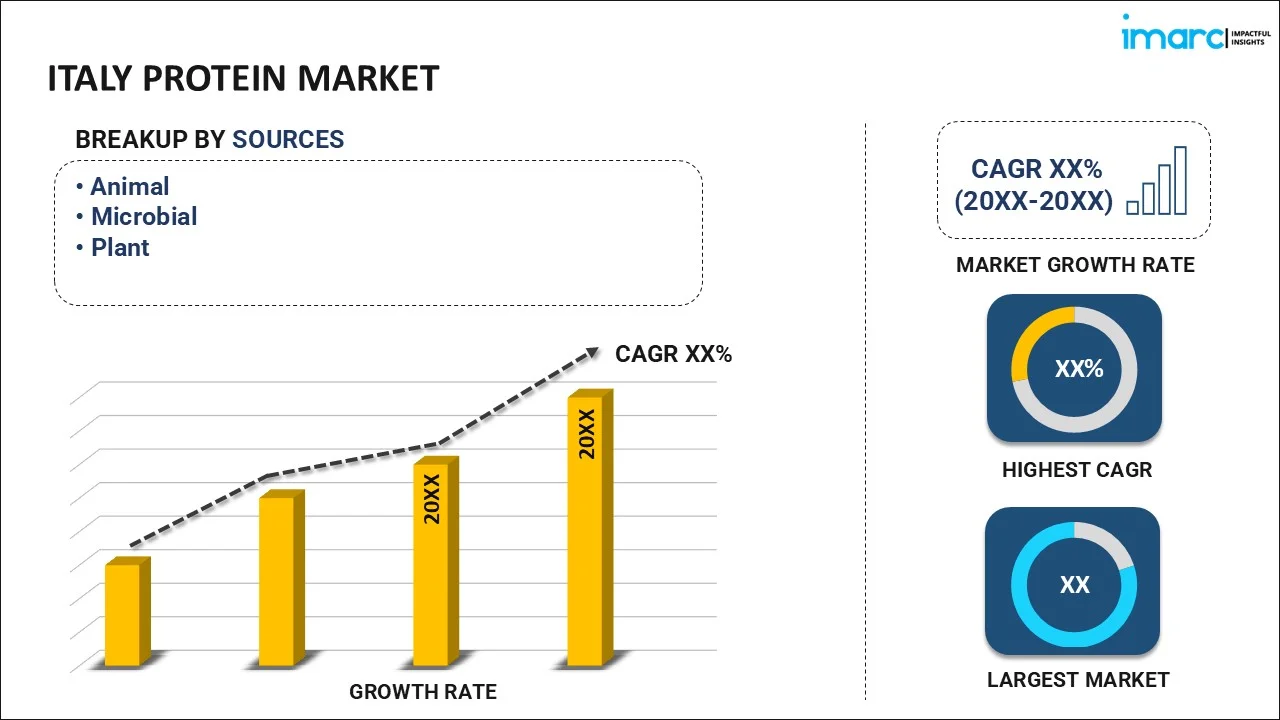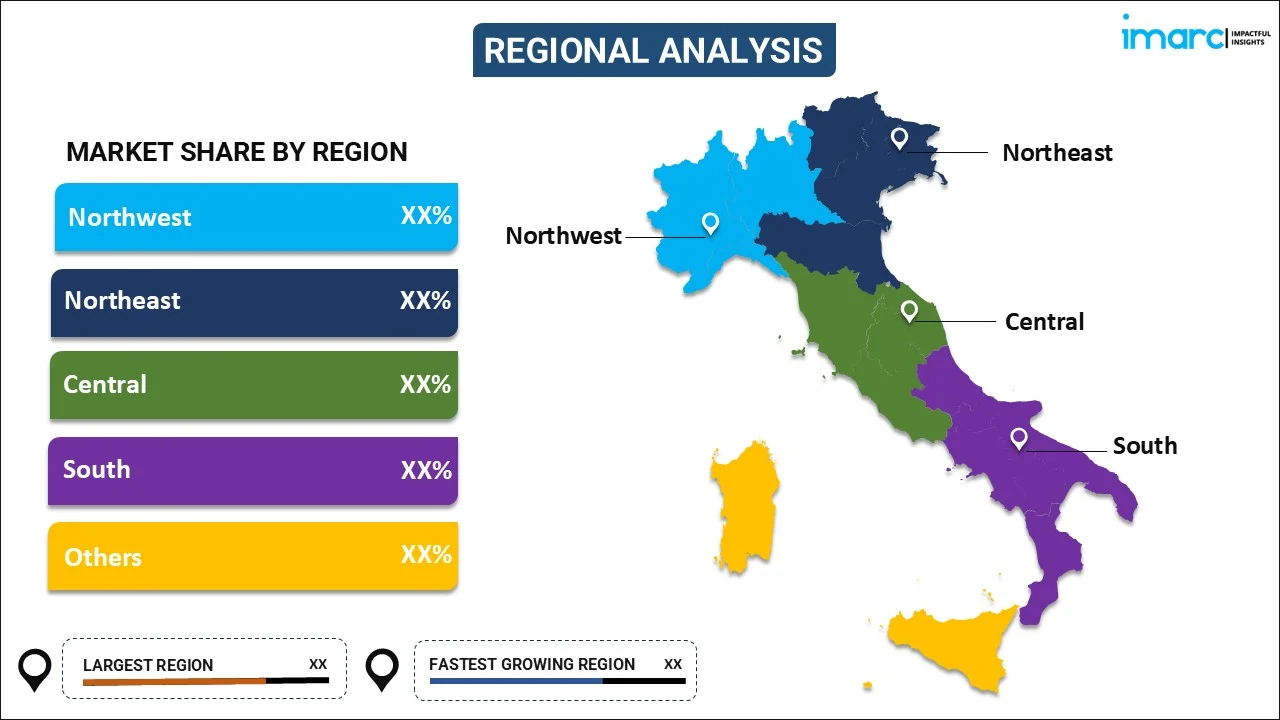
Italy Protein Market Size, Share, Trends and Forecast by Source, End User, and Region, 2025-2033
Italy Protein Market Size and Share:
The Italy protein market size reached USD 510.40 Million in 2024. Looking forward, IMARC Group expects the market to reach USD 920.43 Million by 2033, exhibiting a growth rate (CAGR) of 6.27% during 2025-2033. The Italy protein market is driven by rising health consciousness, increasing demand for plant-based and functional foods, government support for domestic protein crop production, expanding fitness and sports nutrition trends, and growing applications in pharmaceuticals, animal feed, and cosmetics, and consumer adoption of high-protein products across multiple industries.
|
Report Attribute
|
Key Statistics
|
|---|---|
|
Base Year
|
2024
|
|
Forecast Years
|
2025-2033
|
|
Historical Years
|
2019-2024
|
| Market Size in 2024 | USD 510.40 Million |
| Market Forecast in 2033 | USD 920.43 Million |
| Market Growth Rate (2025-2033) | 6.27% |
Italy Protein Market Trends:
Rising Health Consciousness
Over the last few years, Italy has seen a significant change in the behavior of consumers toward more healthy food habits. The reason behind this change is primarily the growing awareness of the importance of a well-balanced diet full of proteins. The Italian National Institute of Statistics (Istat) states that there has been a significant rise in the intake of health-focused food products. In 2023, domestic spending on health-focused food products rose by 1.2% over the year. This is also indicated by statistics on the increase in the consumption of protein-rich food. Although concrete figures on the consumption of proteins are not particularly outlined, overall spending on foods related to health implies an upsurge in demand for them. The same is also depicted in the hike in sales of organic and natural foods, which tend to have more protein content. Efforts from the Italian government to encourage healthy consumption have also been pivotal. Public information campaigns and school programs have placed a strong emphasis on protein in diet, which has influenced consumers to make conscious food choices. Increased health awareness is a major factor in Italy's protein market.
Expansion of the Fitness Industry
The Italian fitness market has developed to a great extent, which has augmented the demand for protein products. With the rise in physical activity, there is growing consciousness about the importance of protein in muscle repair and fitness in general. Statistics provided by Istat show that gross fixed capital formation in the service sector, encompassing recreational and sporting activities, escalated by 8.5% in volume in 2023. This expansion reflects higher investments in gyms and allied services, resulting in a greater number of gym memberships and sports participants. As a result, there is a growing need for protein supplements and protein-rich food items among fitness enthusiasts. The market has reacted with a variety of protein offerings, such as shakes, bars, and enriched foods, targeting this segment. In addition, the surge in social media content with fitness themes has increased the relevance of protein intake, further fueling market development. Social media influencers and fitness professionals tend to tout the virtues of protein, enhancing consumer demand and product adoption. Overall, the intersection of increasing health awareness and growth within the fitness sector are key drivers fueling expansion within Italy's protein market. These trends are underpinned by statistical evidence provided by Istat, capturing shifts in consumer behavior and investment in health and fitness markets.
Italy Protein Market Segmentation:
IMARC Group provides an analysis of the key trends in each segment of the market, along with forecasts at the region/country level for 2025-2033. Our report has categorized the market based on source and end user.
Source Insights:

- Animal
- Casein and Caseinates
- Collagen
- Egg Protein
- Gelatin
- Insect Protein
- Milk Protein
- Whey Protein
- Others
- Microbial
- Algae Protein
- Mycoprotein
- Plant
- Hemp Protein
- Pea Protein
- Potato Protein
- Rice Protein
- Soy Protein
- Wheat Protein
- Others
The report has provided a detailed breakup and analysis of the market based on the source. This includes animal (casein and caseinates, collagen, egg protein, gelatin, insect protein, milk protein, whey protein, and others), microbial (algae protein and mycoprotein), plant (hemp protein, pea protein, potato protein, rice protein, soy protein, wheat protein, and others).
End User Insights:
- Animal Feed
- Personal Care and Cosmetics
- Food and Beverages
- Bakery
- Beverages
- Breakfast Cereals
- Condiments/Sauces
- Confectionery
- Dairy and Dairy Alternative Products
- Meat/Poultry/Seafood and Meat Alternative Products
- RTE/RTC Food Products
- Snacks
- Supplements
- Baby Food and Infant Formula
- Elderly Nutrition and Medical Nutrition
- Sport/Performance Nutrition
A detailed breakup and analysis of the market based on the end user have also been provided in the report. This includes animal feed, personal care and cosmetics, food and beverages (bakery, beverages, breakfast cereals, condiments/sauces, confectionery, dairy and dairy alternative products, meat/poultry/seafood and meat alternative products, RTE/RTC food products, and snacks) and supplements (baby food and infant formula, elderly nutrition and medical nutrition, and sport/performance nutrition).
Regional Insights:

- Northwest
- Northeast
- Central
- South
- Others
The report has also provided a comprehensive analysis of all the major regional markets, which include Northwest, Northeast, Central, South, and others.
Competitive Landscape:
The market research report has also provided a comprehensive analysis of the competitive landscape. Competitive analysis such as market structure, key player positioning, top winning strategies, competitive dashboard, and company evaluation quadrant has been covered in the report. Also, detailed profiles of all major companies have been provided.
Italy Protein Market News:
- January 2025: FAO and Spain are launching a project to enhance food security through the adoption of climate-smart agricultural practices. The project will promote sustainable agriculture, increase crop resilience, and incorporate innovative technologies for enhanced productivity. This propels the Italy protein market by enhancing the supply of quality agricultural inputs, promoting sustainable protein production, and enhancing innovation in plant-based and alternative protein sources.
- March 2024: Ferrero entered the Italian energy bar market with its Fulfil brand, expanding its presence in the health and nutrition segment. The company aimed to meet growing consumer demand for high-protein snacks with innovative formulations. This expanded the Italy protein market by increasing demand for protein ingredients in functional foods and encouraging competition in the nutrition sector.
Italy Protein Market Report Coverage:
| Report Features | Details |
|---|---|
| Base Year of the Analysis | 2024 |
| Historical Period | 2019-2024 |
| Forecast Period | 2025-2033 |
| Units | Million USD |
| Scope of the Report |
Exploration of Historical Trends and Market Outlook, Industry Catalysts and Challenges, Segment-Wise Historical and Future Market Assessment:
|
| Sources Covered |
|
| End Users Covered |
|
| Regions Covered | Northwest, Northeast, Central, South, Others |
| Customization Scope | 10% Free Customization |
| Post-Sale Analyst Support | 10-12 Weeks |
| Delivery Format | PDF and Excel through Email (We can also provide the editable version of the report in PPT/Word format on special request) |
Key Questions Answered in This Report:
- How has the Italy protein market performed so far and how will it perform in the coming years?
- What is the breakup of the Italy protein market on the basis of source?
- What is the breakup of the Italy protein market on the basis of end user?
- What are the various stages in the value chain of the Italy protein market?
- What are the key driving factors and challenges in the Italy protein market?
- What is the structure of the Italy protein market and who are the key players?
- What is the degree of competition in the Italy protein market?
Key Benefits for Stakeholders:
- IMARC’s industry report offers a comprehensive quantitative analysis of various market segments, historical and current market trends, market forecasts, and dynamics of the Italy protein market from 2019-2033.
- The research report provides the latest information on the market drivers, challenges, and opportunities in the Italy protein market.
- Porter's five forces analysis assist stakeholders in assessing the impact of new entrants, competitive rivalry, supplier power, buyer power, and the threat of substitution. It helps stakeholders to analyze the level of competition within the Italy protein industry and its attractiveness.
- Competitive landscape allows stakeholders to understand their competitive environment and provides an insight into the current positions of key players in the market.
Need more help?
- Speak to our experienced analysts for insights on the current market scenarios.
- Include additional segments and countries to customize the report as per your requirement.
- Gain an unparalleled competitive advantage in your domain by understanding how to utilize the report and positively impacting your operations and revenue.
- For further assistance, please connect with our analysts.
 Inquire Before Buying
Inquire Before Buying
 Speak to an Analyst
Speak to an Analyst
 Request Brochure
Request Brochure
 Request Customization
Request Customization




.webp)




.webp)












